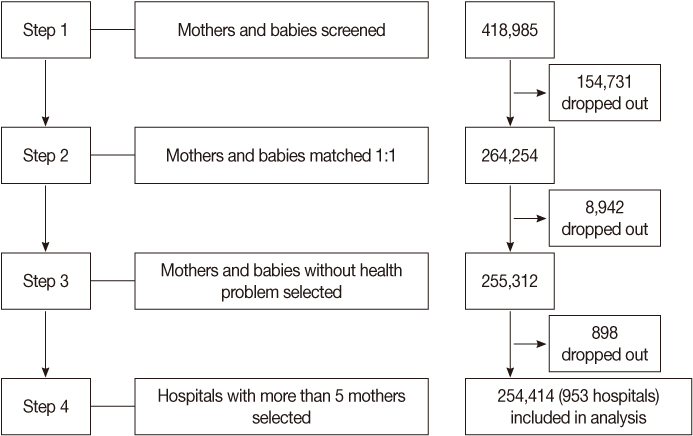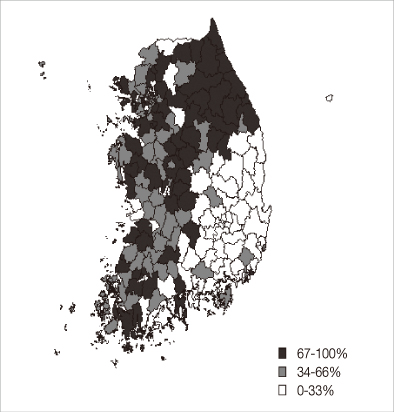J Korean Acad Nurs.
2011 Oct;41(5):593-602. 10.4040/jkan.2011.41.5.593.
Maternal and Hospital Factors Impacting the Utilization of Rooming-in Care in South Korea: Secondary Analysis of National Health Data
- Affiliations
-
- 1Department of Nursing, Eulji university, Seongnam, Korea.
- 2Department of Nursing, Dong-A university, Busan, Korea. eykim@dau.ac.kr
- KMID: 1031098
- DOI: http://doi.org/10.4040/jkan.2011.41.5.593
Abstract
- PURPOSE
Purpose: In this study analysis was done of utilization of rooming-in care in South Korean hospitals in order to examine the factors related to mothers and hospitals that affect rooming-in care.
METHODS
With the involvement of 254,414 mothers who gave birth across 953 hospitals, the analysis used the health insurance qualification data of the National Health Insurance Corporations and Health Insurance Review and Assessment Service (2006). Factors associated with rooming-in care were analyzed using a GEE logistic regression analysis to consider factors related to both mothers and hospitals.
RESULTS
Only 45.1% of the mothers used rooming-in care. The results of the regression analysis revealed that individual factors of the mothers were not associated with rooming-in care, whereas group factors of the hospitals were. Rooming-in care use was primarily related to small hospital, location of hospital, and higher nurse staffing level.
CONCLUSION
The findings of this study indicate that the utilization of rooming-in care is not associated with factors an individual mother, but rather with the group factors of the hospitals. Thus, a policy-based approach considering both of these types of factors is required to enhance the utilization of rooming-in care.
Keyword
MeSH Terms
Figure
Cited by 1 articles
-
Current Status and Availability of Specialized Maternity Non-Standard Room for Delivering Mothers
Jung Won Yoon, Sang Won Han, San Hui Lee, Yeon Soo Jung, Ji Man Kim, Eui Hyeok Kim
Korean J Perinatol. 2014;25(3):159-165. doi: 10.14734/kjp.2014.25.3.159.
Reference
-
1. Aiken LH, Clarke SP, Sloane DM, Sochalski J, Silber J. Hospital nurse staffing and patient mortality, nurse burnout, and job dissatisfaction. Journal of the American Medical Association. 2002. 288:1987–1993. doi: 10.1001/jama.288.16.1987.2. Buchan J, Bretherton T, Bearfield S, Jackson S. Stable but critical: The working conditions of Victorian public sector nurses in 2003. 2004. Retrieved September 1, 2006. from www.acirrt.com.3. Bystrova K, Ivanova V, Edhborg M, Matthiesen A, Ransjo-Arvidson AB, Mukhamedrakhimov R, et al. Early contact versus separation: Effects on mother.infant interaction one year later. Birth. 2009. 36:97–109. doi: 10.1111/j.1523-536X.2009.00307.x.4. Crivelli-Kovach A, Chung EK. An evaluation of hospital breastfeeding policies in the Philadelphia metropolitan area 1994-2009: A comparison with the baby-friendly hospital initiative ten steps. Breastfeeding Medicine. 2011. 6:77–84. doi: 10.1089/bfm.2010.0009.5. Declercq E, Sakala C, Corry MP, Applebaum S, Risher P. Listening to mothers: Report of the first national U.S. survey of women's childbearing experiences. 2002. Retrieved August 5, 2010. from http://www.maternitywise.org/listenintomothers.7. de Oliveira MI, Leal Mdo C. Rooming-in and cesarean section in maternity hospitals in the state of Rio de Janeiro, Brazil. Revista de Saude Publica. 1997. 31:572–580.7. Health Insurance Review & Assessment Service. Evaluation report about cesarean section delivery. 2010. Seoul: Author.8. Katz MH. Multivariable analysis: A practical guide for clinicians. 2006. United Kingdom: Cambridge University Press.9. Kim EY, Kim YM, Kim JS, Cho DS, Kim EK. Attitude and awareness of nurses about rooming-in system. Korean Journal of Women Health Nursing. 2010. 16:137–146.10. Kim YM, Jang HY, Jeong EJ, Kim EY, Kim JS, Kim EK. A study of the improvement of neonatal care system. 2008. Seoul: Hospital Nurses Association.11. Kim YM, Park GY, Jang HR, Jeoung EJ, Kim JS, Kim EY. Comparisons of maternal perceptions between rooming-in and non rooming-in postpartum women. Journal of Korean Clinical Nursing Research. 2009. 15:77–89.12. Lee SC. Comparative analysis of multi-factors influencing on women's choose of rooming-in during their postpartum hospital stay. 2010. Incheon: Inha University;Unpublished master's thesis.13. Levitt CA, Kaczorowski J, Hanvey L, Avard D, Chance GW. Breastfeeding policies and practices in Canadian hospitals providing maternity care. Canadian Medical Association Journal. 1996. 155:181–188.14. Liamputtong P. Giving birth in the hospital: Childbirth experiences of Thai women in northern Thailand. Health Care for Women International. 2004. 25:454–480. doi: 10.1080/07399330490267468.15. Ministry for Health, Welfare and Family Affairs. Guidelines for health promotion program. 2007. Seoul: Authors.16. Ministry for Health, Welfare and Family Affairs, & Korea Health Industry Development Institute. Guidelines for hospital evaluation programme. 2009. Seoul: Authors.17. Medical law. Ministry of Government Legislation. 2010. Retrieved August 5, 2010. from http://www.moleg.go.kr.18. Moore ER, Anderson GC. Randomized controlled trial of very early mother-infant skin-to-skin contact and breastfeeding status. Journal of Midwifery and Women's Health. 2007. 52:116–125.19. Nelson EA, Taylor BJ, Jenik A, Vance J, Walmsley K, Pollard K, et al. International child care practices study: Infant sleeping environment. Early Human Development. 2001. 62:43–55.20. Park SH. Analysis of direct nursing activity and patient outcomes related to graded fee of nursing management for inpatient. Journal of Korean Academy of Nursing. 2003. 33:122–129.21. Reeder SJ, Martin LL, Koniak-griffin D. Maternity nursing. 1997. New York: Lippincott.22. Reise SP, Duan N. Multilevel modeling and its application in counseling psychology research. The Counseling Psychologist. 1999. 27:528–551.23. Rice PL. Rooming-in and cultural practices: Choice or constraint? Journal of Reproductive and Infant Psychology. 2000. 18:21–32.24. Song JE, Lee MK, Chang SB. Differences of maternal fetal attachment between the rooming-in and non rooming-in groups of postpartum women. Journal of Korean Academy of Nursing. 2002. 32:529–538.25. Svensson K, Matthiesen AS, Widstrom AM. Night rooming-in: Who decides? An example of staff influence on mother's attitude. Birth. 2005. 32:99–109. doi: 10.1111/j.0730-7659.2005.00352.x.26. Tu FF, Beaumont JL, Senapati S, Gordon TE. Route of hysterectomy influence and teaching hospital status. Obstetrics and Gynecology. 2009. 114:73–78.27. Ungerer RL, Miranda AT. Rooming-in history. Jornal de Pediatria. 1999. 75:5–10.28. Van den Heede K, Sermeus W, Diya L, Clarke SP, Lesaffre E, Vleugels A, et al. Nurse staffing and patient outcomes in Belgian acute hospitals: Cross-sectional analysis of administrative data. International Journal of Nursing Studies. 2008. 46:928–939. doi: 10.1016/j.ijnurstu.2008.05.007.29. Wennberg JE. Practice variations and health care reform: Connecting the dots. Health Affairs. 2004. Suppl Variation. VAR140–VAR144. doi: 10.1377/hlthaff.var.140.30. World Health Organization. Evidence for the 10 steps to successful breastfeeding (rev.ed., WHO/CHD/98.9). 1998. Geneva: Author.
- Full Text Links
- Actions
-
Cited
- CITED
-
- Close
- Share
- Similar articles
-
- The Effect of Rooming-in on Maternal Attitude and Self Confidence for Infant Care among Primiparas
- Effects of Rooming-in on Continuation of Breastfeeding and Maternal Identity
- Differences of Maternal Fetal Attachment between the Rooming-in and Non-rooming in Groups of Postpartum Women
- Attitude and Awareness of Nurses About Rooming-in System
- Effect of Rooming-in of New Mothers on Breast Feeding Rate



